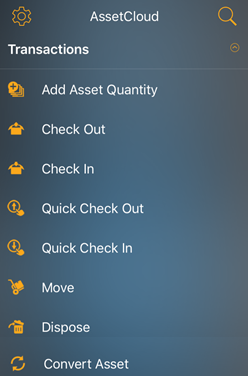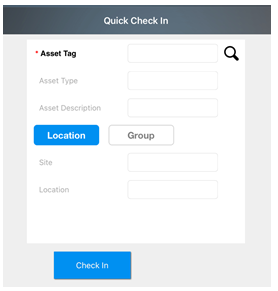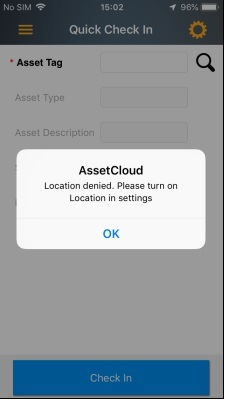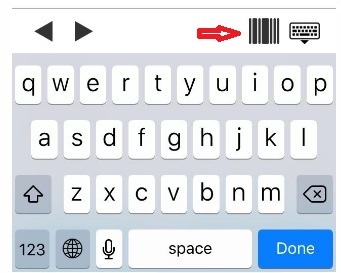iOS Quick Check In
The Check In Asset transaction provides the ability to check in assets currently checked out to a customer, employee or vendor.
You have two options for checking in assets: Check In and Quick Check In.
Check In allows you to check in a number of assets from an employee, customer or vendor, then view the Summary screen where you can collect a signature and/or print a receipt.
Quick Check In can be used when you have many assets you want to check in from different customers/employees/vendors without worrying about gathering signatures on each one. This mode allows you to select a customer, employee or vendor and check in the asset without having to collect signatures or view the summary screen for each transaction.
Note:
- The barcode labeled "scan for a quick check in" that is printed on the check out receipt is only for use with the Web application. The barcode cannot be used with a mobile device.
- Keep in mind that you can "pin" fields on this screen. For more information on pinning, please refer to the topic iOS Pinning Data.
- Most of the screen examples shown in this topic were taken from an iPhone. Examples of screens taken from an iPad are provided when they differ from the iPhone layout.
- Make sure to enable the Capture Transaction Geolocation under settings to capture the Geolocation of the transaction operation.
To Use Quick Check In
Tap on the Transactions > Quick Check In.

The Quick Check In screen will appear.

Note:
- If the Capture Transaction Geolocation under settings is enabled, then a pop-up message will appear asking the user to allow the application to access the device's location. The Geolocation of the transaction will be captured only if the location access is turned on. Click on the Ok button. Click on the Settings (in your mobile) > AssetCloud > Allow AssetCloud to Access - Location to turn on the Location.

- Fields that are followed by an asterisk (*) are mandatory. Also, you can lock the field, refer iOS Pinning Data.
- The Magnifying Glass icon next to a particular field will navigate to the Search screen of that particular field. For example the Magnifying Glass icon next to a location field will navigate to the search location screen.
- You can use the keyboard to enter the information in any field. Or If you want to scan a barcode, use the Barcode scanner. Tap on the Barcode symbol, the scanner will appear. Scan the barcode and the field will display the scanned barcode number.

Enter or scan the Asset Tag or click on the magnifying glass icon to access the Search Asset screen. The Search Asset screen will appear. Search for the asset and tap on the asset tag number.
- If the selected 'Asset' is in a group i.e. a child asset and "Transact as Whole" feature is enabled for the Group - The asset tag field will automatically select the group (i.e. the parent) containing this asset. The View Group button will display all the grouped assets. Example: Consider that HP Charger is a child asset for HP Laptop and Transact as Whole is enabled for HP Laptop. On selecting HP Charger, the asset tag will automatically select HP Laptop.
- If the selected 'Asset' is in a group i.e. a child asset and "Transact as Whole" feature is disabled for the Group - The asset tag field will display the selected asset. The Group Tag field under Group tab will display the group name (i.e. the parent asset). Example - Consider that Plastic Case is a child asset of Mobile. If you select Plastic Case, since Transact As Whole is disabled for the Group (i.e. Mobile) containing Plastic Case, the Asset Tag will display Plastic Case and From Group will display Mobile.
- If the selected asset is a 'Group (parent asset)' and "Transact as Whole" feature is enabled for a group - The asset tag field will select the whole group i.e. all the sub-items will be checked-out by default. The View Group button will display the grouped assets. Example: Consider that there are 3 groups - Container 1, Container 2, Container 3. Container 1 and Container 2 are Transact as whole. If you select Container 1, the parent group i.e Container 2 with transact as whole feature enabled will get selected.
- If the selected asset is a 'Group (parent asset)' and "Transact as Whole" feature is disabled for a group - The asset tag field will select the whole group. The View Group button will display the grouped assets. Example: Consider that there are 3 groups - Container 1, Container 2, Container 3. Container 1 and Container 2 are Transact as whole. Container 3 is not transact as whole. So on selecting container 3, whole group gets selected.
The Description, Site, Location and From Group will populate based on the Asset Tag entered.
A message will appear indicating that the asset is successfully checked In.




